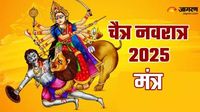Chaitra Navratri, a significant Hindu festival, is set to commence on March 30, 2025, marking a nine-day celebration dedicated to the divine feminine and the revered Goddess Durga. This auspicious occasion, which is celebrated annually in the months of Sharad, Chaitra, Magh, and Ashadh, holds special importance as it symbolizes the arrival of spring and the Hindu New Year.
This year, devotees will have the unique opportunity to witness Maa Durga arriving on an elephant, an event considered particularly auspicious. Each day of the festival is dedicated to a different form of Goddess Durga, collectively known as Navadurga, and encompasses various rituals, prayers, fasting, and cultural events.
The first day of Chaitra Navratri, falling on March 30, will be marked by Ghatasthapana, Chandra Darshan, and the worship of Maa Shailputri, the first form of the Goddess. Maa Shailputri, also known as Sati, Hemavati, Vrishorudha, and Uma, symbolizes willpower and inner strength. Devotees are encouraged to wear yellow clothing on this day and offer red flowers and pure cow's ghee during the worship. It is believed that worshipping Maa Shailputri removes all negative influences from one's life.
On the second day, March 31, the focus shifts to Maa Brahmacharini, who governs the planet Mars. Her worship is said to alleviate sorrow and suffering, and devotees should wear green clothes while offering white flowers and sugar as bhog. The story of Maa Brahmacharini highlights her years of penance, which earned her the divine status she holds today.
The third day, April 1, is dedicated to Maa Chandraghanta, who represents courage and fearlessness. She is depicted with a golden body and a bell-shaped half-moon on her forehead, riding a tiger. Worshipping her is believed to instill strength and dispel fears. Devotees should wear grey clothing and offer red flowers and milk or milk-based sweets during her puja.
On April 2, the fourth day, devotees will honor Maa Kushmanda, also known as Ashtabhuja Devi. She is associated with creation and is believed to have created the universe from a pind. Worshippers should don green attire and offer malpua as bhog, along with various green items during the puja.
The fifth day, April 3, is dedicated to Maa Skandamata, the fierce form of Maa Parvati. The story of her fierce manifestation to protect her son, Kumar Kartikeya, is well-known. Worshipping her can resolve issues related to children, and devotees should wear yellow clothing and offer bananas during her puja.
On April 4, the sixth day, Maa Katyayani is worshipped. Named after Rishi Katyayan, she embodies female energy and is said to bless devotees with wealth, religious fulfillment, and spiritual liberation. To honor her, devotees should wear red clothing, offer honey and yellow flowers, and seek blessings for quick marriages.
The seventh day, April 5, is reserved for Maa Kalaratri, known by names such as Kali and Chamunda. Her worship is said to eradicate all sorrows. Devotees should offer jaggery and perform the puja with incense and aromatic sticks.
On April 6, the eighth day, devotees will worship Maa Mahagauri, who is also referred to as Shwetambardhara due to her white attire. Her story involves severe penance to win the love of Lord Shiva. Worshipping her is believed to bring desired marriages and a happy married life. Devotees should wear white clothing and offer coconuts and white flowers during her puja.
The final day of Chaitra Navratri, April 7, coincides with Ram Navami, when Maa Siddhidatri is worshipped. She is depicted seated on a lotus and is known to bestow all kinds of siddhis or spiritual powers. Devotees are advised to wear purple clothing and offer black sesame seeds, along with various flowers, during her worship.
Throughout these nine days, devotees engage in fasting, prayers, and cultural activities, including Garba and Dandiya Raas, to honor the divine feminine. The puja vidhi involves a series of rituals, starting with the installation of the Goddess's idol or picture, followed by specific offerings and prayers for each of her forms. The puja is ideally performed during Brahma Muhurta, a time considered highly auspicious for spiritual activities.
Chaitra Navratri serves as a reminder of the strength and power of women, as well as a time for self-reflection and spiritual growth. As the festival approaches, devotees across India prepare to celebrate with devotion and enthusiasm, seeking blessings from Maa Durga for health, prosperity, and happiness.





